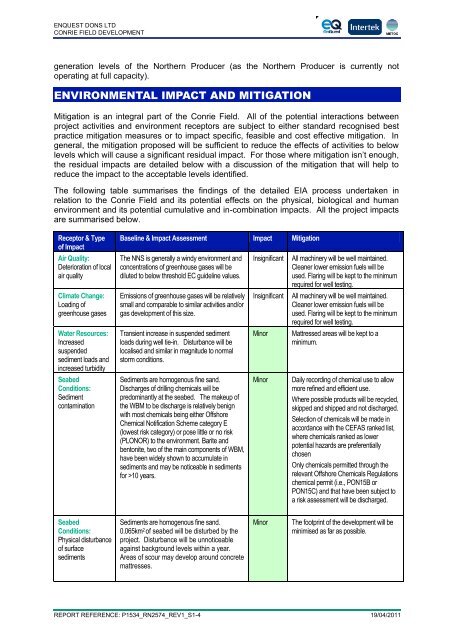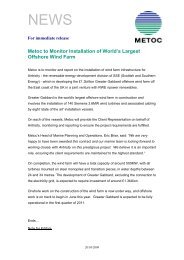Conrie Field Development Environmental Statement - Metoc
Conrie Field Development Environmental Statement - Metoc
Conrie Field Development Environmental Statement - Metoc
Create successful ePaper yourself
Turn your PDF publications into a flip-book with our unique Google optimized e-Paper software.
ENQUEST DONS LTD<br />
CONRIE FIELD DEVELOPMENT<br />
generation levels of the Northern Producer (as the Northern Producer is currently not<br />
operating at full capacity).<br />
ENVIRONMENTAL IMPACT AND MITIGATION<br />
Mitigation is an integral part of the <strong>Conrie</strong> <strong>Field</strong>. All of the potential interactions between<br />
project activities and environment receptors are subject to either standard recognised best<br />
practice mitigation measures or to impact specific, feasible and cost effective mitigation. In<br />
general, the mitigation proposed will be sufficient to reduce the effects of activities to below<br />
levels which will cause a significant residual impact. For those where mitigation isn‟t enough,<br />
the residual impacts are detailed below with a discussion of the mitigation that will help to<br />
reduce the impact to the acceptable levels identified.<br />
The following table summarises the findings of the detailed EIA process undertaken in<br />
relation to the <strong>Conrie</strong> <strong>Field</strong> and its potential effects on the physical, biological and human<br />
environment and its potential cumulative and in-combination impacts. All the project impacts<br />
are summarised below.<br />
Receptor & Type<br />
of Impact<br />
Air Quality:<br />
Deterioration of local<br />
air quality<br />
Climate Change:<br />
Loading of<br />
greenhouse gases<br />
Water Resources:<br />
Increased<br />
suspended<br />
sediment loads and<br />
increased turbidity<br />
Seabed<br />
Conditions:<br />
Sediment<br />
contamination<br />
Baseline & Impact Assessment Impact Mitigation<br />
The NNS is generally a windy environment and<br />
concentrations of greenhouse gases will be<br />
diluted to below threshold EC guideline values.<br />
Emissions of greenhouse gases will be relatively<br />
small and comparable to similar activities and/or<br />
gas development of this size.<br />
Transient increase in suspended sediment<br />
loads during well tie-in. Disturbance will be<br />
localised and similar in magnitude to normal<br />
storm conditions.<br />
Sediments are homogenous fine sand.<br />
Discharges of drilling chemicals will be<br />
predominantly at the seabed. The makeup of<br />
the WBM to be discharge is relatively benign<br />
with most chemicals being either Offshore<br />
Chemical Notification Scheme category E<br />
(lowest risk category) or pose little or no risk<br />
(PLONOR) to the environment. Barite and<br />
bentonite, two of the main components of WBM,<br />
have been widely shown to accumulate in<br />
sediments and may be noticeable in sediments<br />
for >10 years.<br />
Insignificant<br />
Insignificant<br />
Minor<br />
Minor<br />
All machinery will be well maintained.<br />
Cleaner lower emission fuels will be<br />
used. Flaring will be kept to the minimum<br />
required for well testing.<br />
All machinery will be well maintained.<br />
Cleaner lower emission fuels will be<br />
used. Flaring will be kept to the minimum<br />
required for well testing.<br />
Mattressed areas will be kept to a<br />
minimum.<br />
Daily recording of chemical use to allow<br />
more refined and efficient use.<br />
Where possible products will be recycled,<br />
skipped and shipped and not discharged.<br />
Selection of chemicals will be made in<br />
accordance with the CEFAS ranked list,<br />
where chemicals ranked as lower<br />
potential hazards are preferentially<br />
chosen<br />
Only chemicals permitted through the<br />
relevant Offshore Chemicals Regulations<br />
chemical permit (i.e., PON15B or<br />
PON15C) and that have been subject to<br />
a risk assessment will be discharged.<br />
Seabed<br />
Conditions:<br />
Physical disturbance<br />
of surface<br />
sediments<br />
Sediments are homogenous fine sand.<br />
0.065km 2 of seabed will be disturbed by the<br />
project. Disturbance will be unnoticeable<br />
against background levels within a year.<br />
Areas of scour may develop around concrete<br />
mattresses.<br />
Minor<br />
The footprint of the development will be<br />
minimised as far as possible.<br />
REPORT REFERENCE: P1534_RN2574_REV1_S1-4 19/04/2011




